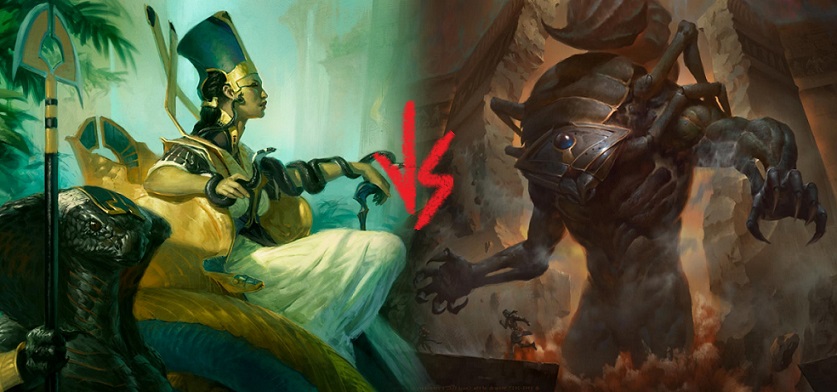V for Venom-Detta
Voilà! In view, the vast valleys of Ixalan! However, now that we've arrived at this vivid, vibrant vista, we must veer our vessel back to Amonkhet! We volunteered to visit two voracious veterans before the Hour of Devastation vanishes, and they would be very vexed and vindictive if we vacated our vow. If you, valuable viewer, would rather vie for a fix of Ixalan (a Fixalan, if you will) please visit our previous Commander Showdown, Tishana vs Zegana. For now, let us voyage away from these vicious velociraptors and vein-drinking vampires and instead investigate a Showdown between two vehemently venomous viziers of vermin: Hapatra, Vizier of PoisonsHapatra, Vizier of Poisons and The Scorpion GodThe Scorpion God!
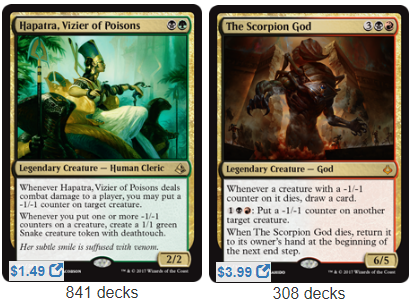
Verily, I can vouch that the virtuous, voguish victim Hapatra and the vile, visceral visage of the Scorpion God verge on valid and viable versions of violent and vicarious vagrancy, but with varying vices. Now, in case this veritably verbose volley of verbiage makes you vaguely want to vomit, let us get on with the show! I've had more than a few requests for a Showdown between these two -1/-1 counter monsters. Let's see who emerges victorious.
Minus One, Minus One
Hapatra, Vizier of PoisonsHapatra, Vizier of Poisons brought us a ton of fun in Amonkhet. A succinct 2/2 for two mana, she boasts the unique ability to create deathtouching snake tokens every time you place one or more -1/-1 counters on a creature. (Note that this ability is slightly different than Flourishing DefensesFlourishing Defenses or Nest of ScarabsNest of Scarabs, both of which create a token for each counter placed on a creature, though Nest is limited to counters you place.) Golgari commanders are already fairly diverse, from Meren of Clan Nel TothMeren of Clan Nel Toth's necromancy to Glissa the TraitorGlissa the Traitor's artifice to The Gitrog MonsterThe Gitrog Monster's land consumption. Hapatra opened up even more new territory for this color combination, providing focus for the -1/-1 counter strategies from both the Amonkhet and Shadowmoor blocks and giving us an excellent go-wide token strategy as a payoff.
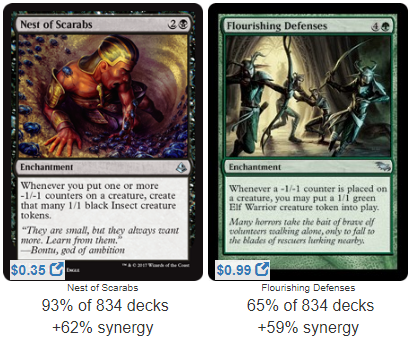
Then, along came a spider. Er---I mean Scorpion. The Scorpion GodThe Scorpion God arrived in Hour of Devastation and opened up new territory for its color combination as well, this time the red-black Rakdos. Here was another -1/-1 counter commander, which rewarded us not with Snake tokens, but card advantage. In addition, it promised never to accumulate commander tax. Like The Scarab GodThe Scarab God and The Locust GodThe Locust God (whose Showdowns you can read here and here) this new arachnid returns to the hand when killed, avoiding the extra costs from the command zone, nearly always keeping it a young and healthy 6/5 for five mana. In addition, it came with one extra feature: the ability to place -1/-1 counters on creatures, all by itself.
Sadly, we don't yet have a Jund commander that can fit both Hapatra and the Scorpion into a single red-green-black -1/-1 counter deck. As it stands, we have to make the choice between Scorpion or Snake, stinger or fang, eight legs or none at all. Let's delve into their strategies and see if we can't make that choice a little easier.
V for Venn Diagram
It's been a while since I've been able to do a proper Venn Diagram. The most recent Showdowns have featured commanders from Ixalan and Commander 2017, which were a little too new to have much data here on EDHREC. Thankfully, that's not the case for Hapatra and the Scorpion God. Scorpy (yes, I call him Scorpy, we're on first-name basis) features a respectable 300 decks here on the website, and Hapatra pulls in a whopping 841, the third-highest green-black commander. It's safe to say we have a lot of information about them, so let's put that information to use! Below I've arranged their Top and Signature cards to see which cards overlap. This should give us a sense of where their strategies align, and more importantly, where they differ. Take a look:
| Hapatra | Both | Scorpy |
|---|---|---|
| Wickerbough ElderWickerbough Elder | NecroskitterNecroskitter | Kulrath KnightKulrath Knight |
| Obelisk SpiderObelisk Spider | Blowfly InfestationBlowfly Infestation | Everlasting TormentEverlasting Torment |
| Flourishing DefensesFlourishing Defenses | Contagion ClaspContagion Clasp | Corrosive MentorCorrosive Mentor |
| SkullclampSkullclamp | Black Sun's ZenithBlack Sun's Zenith | Rakdos SignetRakdos Signet |
| Channeler InitiateChanneler Initiate | Carnifex DemonCarnifex Demon | TerminateTerminate |
| Beastmaster AscensionBeastmaster Ascension | Midnight BansheeMidnight Banshee | Blasphemous ActBlasphemous Act |
| Parallel LivesParallel Lives | Contagion EngineContagion Engine | Rakdos CharmRakdos Charm |
| Devoted DruidDevoted Druid | Nest of ScarabsNest of Scarabs | VandalblastVandalblast |
| Cryptolith RiteCryptolith Rite | Dusk UrchinsDusk Urchins | HateflayerHateflayer |
| PutrefyPutrefy | Grim AfflictionGrim Affliction | DreadboreDreadbore |
| QuillspikeQuillspike | Soul SnuffersSoul Snuffers | Talisman of IndulgenceTalisman of Indulgence |
| Golgari SignetGolgari Signet | Crumbling AshesCrumbling Ashes | Thought VesselThought Vessel |
| Seshiro the AnointedSeshiro the Anointed | SkinrenderSkinrender | Solemn SimulacrumSolemn Simulacrum |
| Decimator BeetleDecimator Beetle | Incremental BlightIncremental Blight | Cauldron of SoulsCauldron of Souls |
There's an obvious observation to make here, one that (hopefully) surprises no one: Hapatra is green, and the Scorpion god is red. As a result, their respective columns contain a lot of cards the other can't access whatsoever, while the "Both" column is stuffed with nearly every thinkable black card that so much as mentions a -1/-1 counter.
Look closer, though. There are a few exceptions, and we can learn a lot from them. True, Hapatra can't touch Kulrath KnightKulrath Knight, but she can use Corrosive MentorCorrosive Mentor, yet it isn't important enough to feature in her Top or Signature cards. There's an additional smattering of other artifacts Hapatra doesn't seem as interested in, such as Solemn SimulacrumSolemn Simulacrum and Thought VesselThought Vessel. Since she's green and has access to hyper-efficient ramp spells, this makes sense. The more important standout is Cauldron of SoulsCauldron of Souls, which can potentially give lots of creatures -1/-1 counters. This sounds like it'd be right in Hapatra's wheelhouse, yet it too sees less play.

These are only a few clues, but we can extrapolate a lot from them. We know from the Beastmaster AscensionBeastmaster Ascension in her column that Hapatra, Vizier of PoisonsHapatra, Vizier of Poisons likes token armies, but the cards missing from her column are even more revealing. Cauldron of SoulsCauldron of Souls's absence tells us that her love of tokens is actually very extreme. The Cauldron can't bring back tokens—once they die, they're gone for good—so even though she could Persist herself or her nontoken minions and gain more creatures in the process, that isn't a compelling enough reason to run the card over, say, a spell that could save her entire army, such as Eldrazi MonumentEldrazi Monument or Heroic InterventionHeroic Intervention.
Not only that, but the lack of Corrosive MentorCorrosive Mentor shows us that Hapatra's token production is, for lack of a better word, narcissistic. Since her snakes are green, they don't synergize with Corrosive MentorCorrosive Mentor, but other black creatures would. Even so, the card has lower popularity, signaling that her black creatures will be few in number and largely noncombative. They're utility creatures, too valuable to lose in battle. Her snakes do all the punching.
While interesting, these are really only surface-level understandings of Hapatra, so we should go a bit deeper. We'll get back to Scorpy in a second. For now, I'm interested in finding out a bit more about our green-black-minus-counter-Cleopatra-inspired mistress.
In the Green Corner...
Hapatra's access to green opens up a lot of doors for tokens. Let's take a look at her average decklist and see what we find there.
Average Hapatra Deck
View on ArchidektCommander (1)
- 1 Hapatra, Vizier of PoisonsHapatra, Vizier of Poisons
Creatures (27)
- 1 Ammit EternalAmmit Eternal
- 1 Banewhip PunisherBanewhip Punisher
- 1 Blood ArtistBlood Artist
- 1 Carnifex DemonCarnifex Demon
- 1 Channeler InitiateChanneler Initiate
- 1 Corrosive MentorCorrosive Mentor
- 1 Craterhoof BehemothCraterhoof Behemoth
- 1 Creakwood LiegeCreakwood Liege
- 1 Decimator BeetleDecimator Beetle
- 1 Devoted DruidDevoted Druid
- 1 Dusk UrchinsDusk Urchins
- 1 Eternal WitnessEternal Witness
- 1 Grim PoppetGrim Poppet
- 1 Midnight BansheeMidnight Banshee
- 1 NecroskitterNecroskitter
- 1 Noxious HatchlingNoxious Hatchling
- 1 Obelisk SpiderObelisk Spider
- 1 Plaguemaw BeastPlaguemaw Beast
- 1 Puppeteer CliquePuppeteer Clique
- 1 QuillspikeQuillspike
- 1 Sakura-Tribe ElderSakura-Tribe Elder
- 1 Seshiro the AnointedSeshiro the Anointed
- 1 SkinrenderSkinrender
- 1 Soul SnuffersSoul Snuffers
- 1 Vhati il-DalVhati il-Dal
- 1 Wickerbough ElderWickerbough Elder
- 1 Zulaport CutthroatZulaport Cutthroat
Instants (6)
- 1 Beast WithinBeast Within
- 1 Grim AfflictionGrim Affliction
- 1 Krosan GripKrosan Grip
- 1 PutrefyPutrefy
- 1 Second HarvestSecond Harvest
- 1 Splendid AgonySplendid Agony
Sorceries (10)
- 1 Black Sun's ZenithBlack Sun's Zenith
- 1 CultivateCultivate
- 1 Demonic TutorDemonic Tutor
- 1 Diabolic TutorDiabolic Tutor
- 1 Driven // DespairDriven // Despair
- 1 Green Sun's ZenithGreen Sun's Zenith
- 1 Incremental BlightIncremental Blight
- 1 Kodama's ReachKodama's Reach
- 1 Liliana's InfluenceLiliana's Influence
- 1 Triumph of the HordesTriumph of the Hordes
Artifacts (10)
- 1 Cauldron of SoulsCauldron of Souls
- 1 Contagion ClaspContagion Clasp
- 1 Contagion EngineContagion Engine
- 1 Eldrazi MonumentEldrazi Monument
- 1 Golgari SignetGolgari Signet
- 1 Serrated ArrowsSerrated Arrows
- 1 SkullclampSkullclamp
- 1 Sol RingSol Ring
- 1 Trigon of CorruptionTrigon of Corruption
- 1 Whispersilk CloakWhispersilk Cloak
Enchantments (10)
- 1 Beastmaster AscensionBeastmaster Ascension
- 1 Blowfly InfestationBlowfly Infestation
- 1 Crumbling AshesCrumbling Ashes
- 1 Cryptolith RiteCryptolith Rite
- 1 Deathreap RitualDeathreap Ritual
- 1 Dictate of ErebosDictate of Erebos
- 1 Flourishing DefensesFlourishing Defenses
- 1 Nest of ScarabsNest of Scarabs
- 1 Parallel LivesParallel Lives
- 1 Phyrexian ArenaPhyrexian Arena
Planeswalkers (1)
- 1 Liliana, Death WielderLiliana, Death Wielder
Lands (35)
- 1 Bojuka BogBojuka Bog
- 1 Command TowerCommand Tower
- 1 Evolving WildsEvolving Wilds
- 1 Golgari Rot FarmGolgari Rot Farm
- 1 Grasping DunesGrasping Dunes
- 1 Jungle HollowJungle Hollow
- 1 Llanowar WastesLlanowar Wastes
- 1 Oran-Rief, the VastwoodOran-Rief, the Vastwood
- 1 Overgrown TombOvergrown Tomb
- 1 Rogue's PassageRogue's Passage
- 1 Tainted WoodTainted Wood
- 1 Temple of MaladyTemple of Malady
- 1 Woodland CemeteryWoodland Cemetery
- 13 SwampSwamp
- 9 ForestForest
Cauldron of SoulsCauldron of Souls and Corrosive MentorCorrosive Mentor did make the final cut, which is good to see, but we know they're not her top picks. I love seeing Vhati il-DalVhati il-Dal here, which can turn any creature into a 1/1 just by giving it a stern look. Any creature with one of Hapatra's counters on it is fresh meat for Vhati, making him a pseudo-Bounty HunterBounty Hunter.
The Blood ArtistBlood Artist effects are very appealing as well. Hapatra thrives off of death; it's practically in the Code of Honor for a Golgari commander. When compounded, her counters inevitably kill their hosts, which she capitalizes on by enlarging her army. That's not the only thing that makes Blood ArtistBlood Artist effects an interesting inclusion, however. Death triggers are actually a very important lens through which to view Hapatra's myriad of -1/-1 counter effects.
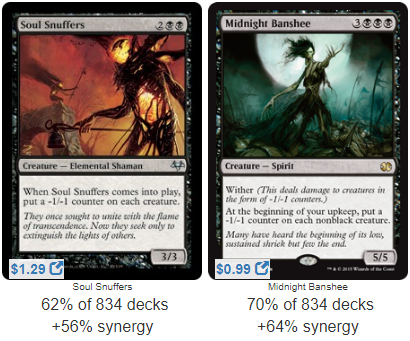
For instance, take a look at Soul SnuffersSoul Snuffers. When this creature enters the battlefield, it puts a -1/-1 counter on every creature. This includes itself. This includes Hapatra. This includes her tokens. Soul SnuffersSoul Snuffers kills off her entire 1/1 army, but Hapatra doesn't actually care. In fact, she invites it, because every -1/-1 counter that kills off a snake just produces another. Midnight BansheeMidnight Banshee is similar, and even more devastating, because it kills off her army every turn. The snakes don't even get the chance to attack! In any other deck, such effects might be considered anti-synergy, but Hapatra can turn this perpetual death engine into her gain. Every dead token is just another excellent trigger for Zulaport CutthroatZulaport Cutthroat and friends.
So look carefully at Hapatra's -1/-1 counter effects. They tend to be widespread, to create as many snakes as possible, but they can also be ruthless and reflexive, affecting her own board. After all, if you've already killed off all your opponents' creatures, what better way to make more tokens than by putting counters on your own creatures?
Snakes... Why Did it Have to be Snakes?
Which brings me to combat. Hapatra has an interesting relationship with anthem effects (that is, cards that power up her army). I was surprised to see that her average decklist contains very few cards that buff up her massive army. There are some very respectable effects: Craterhoof BehemothCraterhoof Behemoth, Seshiro the AnointedSeshiro the Anointed, the aforementioned Beastmaster AscensionBeastmaster Ascension, and even Creakwood LiegeCreakwood Liege. In total, though, there are only about six anthems in her deck.

This number strikes me as very low. Token-swarm strategies tend to run this effect in much larger quantities. For example, Rhys the RedeemedRhys the Redeemed is a famous token commander, and in looking over his average decklist I found no less than seventeen cards that boost up power and toughness. Even Nath of the Gilt LeafNath of the Gilt Leaf's average deck, which divides its attention between discard effects and elf armies, contains ten different cards that can power up creatures. Why does Hapatra run fewer of these effects than other token-makers?
The reason is pretty simple, actually. Hapatra's snakes are unique among tokens because they have deathtouch. They don't need to be powerful, they'll already take enemy creatures down with them. Besides, if Hapatra has done her job correctly, she'll have weakened most of the creatures in her way in the first place. Anthems are therefore less important. While other token decks use powerups to help them win general combat, Hapatra only needs the ones that provide extra-crucial value. Eldrazi MonumentEldrazi Monument grants indestructible, for example, and Triumph of the HordesTriumph of the Hordes and Craterhoof BehemothCraterhoof Behemoth are famous for their ability to end the game on the spot. (Trample, by the way, pairs excellently with deathtouching snakes.)
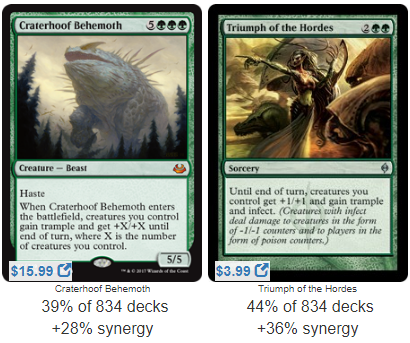
All in all, Hapatra, Vizier of PoisonsHapatra, Vizier of Poisons leaves us with a sense of inexorability. Her deck is aggressive, not because her army is always powerful, but because her army is just plain unstoppable. Deathtouch tokens make her difficult to block, and even more difficult to attack. If you've seen Game Knights episode that features Hapatra, you'll also notice Hapatra's impressive ability to recoup even after multiple board wipes. Noncreature cards like Serrated ArrowsSerrated Arrows, Flourishing DefensesFlourishing Defenses, and Contagion EngineContagion Engine outlive most wrath effects, and can quickly put Hapatra back on the map. Plus, her own repeating cycle of self-inflicted death triggers combines so well with Blood ArtistBlood Artist that she can gradually close out the game even without combat.
If you like tokens, Hapatra is the obvious choice for -1/-1 counter commander, but it's important to recognize the deeper strategy at work here. She's not a typical token commander. While most swarm decks fear death, Hapatra embraces it as a potential ally. She can pack a huge punch like the rest of them, but she's also content to whittle away her enemies, bit by bit. Like poison creeping through veins, Hapatra is subtle, but if you let her get too far without treatment, her takeover is inevitable.
In the Red Corner...
Alright, we've ignored The Scorpion GodThe Scorpion God for far too long. How does a -1/-1 counter strategy shift when you replace green with red?
As we saw with the Venn Diagram, there are only a small handful of worthwhile red cards that mention -1/-1 counters. Kulrath KnightKulrath Knight, Everlasting TormentEverlasting Torment, and HateflayerHateflayer make a showing for Scorpy, but the list dries up pretty quickly after that. Unfortunately, red only has the Shadowmoor block to draw from, while green has the Shadowmoor, Scars of Mirrodin, and Amonkhet blocks for inspiration. This leaves red with underwhelming spells like ScarScar and Puncture BlastPuncture Blast. We saw with Hapatra's decklist that most of the -1/-1 counter spells were black, but for The Scorpion GodThe Scorpion God, that disparity is even more pronounced.
Let's take a look at Scorpy's average decklist and see what he's up to:
Average Scorpy Deck
View on ArchidektCommander (1)
- 1 The Scorpion GodThe Scorpion God
Creatures (23)
- 1 Archfiend of IfnirArchfiend of Ifnir
- 1 Burnished HartBurnished Hart
- 1 Carnifex DemonCarnifex Demon
- 1 Corrosive MentorCorrosive Mentor
- 1 Crypt GhastCrypt Ghast
- 1 Dusk UrchinsDusk Urchins
- 1 Grief TyrantGrief Tyrant
- 1 Grim PoppetGrim Poppet
- 1 Harbinger of NightHarbinger of Night
- 1 HateflayerHateflayer
- 1 Kulrath KnightKulrath Knight
- 1 Lockjaw SnapperLockjaw Snapper
- 1 Merciless JavelineerMerciless Javelineer
- 1 Midnight BansheeMidnight Banshee
- 1 NecroskitterNecroskitter
- 1 Plague MyrPlague Myr
- 1 Puppeteer CliquePuppeteer Clique
- 1 SkinrenderSkinrender
- 1 Solemn SimulacrumSolemn Simulacrum
- 1 Soul SnuffersSoul Snuffers
- 1 Soul-Scar MageSoul-Scar Mage
- 1 SoulstingerSoulstinger
- 1 Stigma LasherStigma Lasher
Instants (8)
- 1 Chaos WarpChaos Warp
- 1 Grim AfflictionGrim Affliction
- 1 Puncture BlastPuncture Blast
- 1 Rakdos CharmRakdos Charm
- 1 Splendid AgonySplendid Agony
- 1 Sudden SpoilingSudden Spoiling
- 1 TerminateTerminate
- 1 Volt ChargeVolt Charge
Sorceries (11)
- 1 Black Sun's ZenithBlack Sun's Zenith
- 1 Blasphemous ActBlasphemous Act
- 1 Chandra's IgnitionChandra's Ignition
- 1 Decree of PainDecree of Pain
- 1 Demonic TutorDemonic Tutor
- 1 Diabolic TutorDiabolic Tutor
- 1 DreadboreDreadbore
- 1 Grave UpheavalGrave Upheaval
- 1 Incremental BlightIncremental Blight
- 1 Liliana's InfluenceLiliana's Influence
- 1 VandalblastVandalblast
Artifacts (11)
- 1 Cauldron of SoulsCauldron of Souls
- 1 Commander's SphereCommander's Sphere
- 1 Contagion ClaspContagion Clasp
- 1 Contagion EngineContagion Engine
- 1 Lightning GreavesLightning Greaves
- 1 Mind StoneMind Stone
- 1 Rakdos SignetRakdos Signet
- 1 SkullclampSkullclamp
- 1 Sol RingSol Ring
- 1 Talisman of IndulgenceTalisman of Indulgence
- 1 Thought VesselThought Vessel
Enchantments (8)
- 1 Black MarketBlack Market
- 1 Blowfly InfestationBlowfly Infestation
- 1 Crumbling AshesCrumbling Ashes
- 1 Everlasting TormentEverlasting Torment
- 1 Fists of the DemigodFists of the Demigod
- 1 Glistening OilGlistening Oil
- 1 Nest of ScarabsNest of Scarabs
- 1 Phyrexian ArenaPhyrexian Arena
Planeswalkers (1)
- 1 Liliana, Death WielderLiliana, Death Wielder
Lands (37)
- 1 Barren MoorBarren Moor
- 1 Blood CryptBlood Crypt
- 1 Bloodfell CavesBloodfell Caves
- 1 Bloodstained MireBloodstained Mire
- 1 Bojuka BogBojuka Bog
- 1 Canyon SloughCanyon Slough
- 1 Command TowerCommand Tower
- 1 Dragonskull SummitDragonskull Summit
- 1 Foreboding RuinsForeboding Ruins
- 1 Graven CairnsGraven Cairns
- 1 Rakdos CarnariumRakdos Carnarium
- 1 Reliquary TowerReliquary Tower
- 1 Smoldering MarshSmoldering Marsh
- 1 Tainted PeakTainted Peak
- 1 Temple of MaliceTemple of Malice
- 15 SwampSwamp
- 7 MountainMountain
As expected, the list is largely black, with just hint of red for cool spells like Chaos WarpChaos Warp and Rakdos CharmRakdos Charm. Stigma LasherStigma Lasher is another solid inclusion, punishing careless opponents and slotting nicely into the -1/-1 counter theme.
In my opinion, the most interesting cards actually lie outside the -1/-1 counter theme. Black MarketBlack Market, Chandra's IgnitionChandra's Ignition, Decree of PainDecree of Pain, and Sudden SpoilingSudden Spoiling all reveal something pretty important about the way The Scorpion GodThe Scorpion God works. Remember, Scorpy doesn't care how many counters a creature has, just that it has at least one. By spreading counters widely, Scorpy can turn a DamnationDamnation into a Decree of PainDecree of Pain.

This kind of plan is pretty familiar to anyone who bought the Vampiric Bloodlust precon for Commander 2017. Tagging creatures with counters and reveling in their death sounds a whole lot like Mathas, the Fiend SeekerMathas, the Fiend Seeker. Instead of giving the benefits to multiple players, you get to keep the prizes for yourself. (Unlike Mathas, though, you do have to make sure Scorpy at least sticks around long enough to see the marked creatures die.) This is why cards like Black MarketBlack Market and expensive board wipes like Decree of PainDecree of Pain make sense for a Scorpion God deck. To get the most benefit, you want to see lots of creatures die, which means you want the game to go a little long.
In short, The Scorpion GodThe Scorpion God uses attrition as a resource. Though it boasts an impressive 6/5 body, Scorpy is more suited for Rakdos control than reckless combat. There's a reason Kulrath KnightKulrath Knight is Scorpion's #1 Signature Card, and it's not just because it mentions -1/-1 counters—it's because it locks down the board and turns your opponents into marionettes. Where Hapatra uses -1/-1 counters to create an aggressively encroaching army, scuttly little Scorpy actually takes a backseat, to oversee as much death and carnage as possible. Unlike the lore, where the god faces other creatures head-on in combat, in a game of EDH, the Scorpmander is uncharacteristically gradual. In fact, I think it's more useful to think of Scorpy not as a -1/-1 counter commander, but as a cross between Mathas, Fiend SeekerMathas, Fiend Seeker and Olivia VoldarenOlivia Voldaren (the non-vampire-tribal version, I mean.) Inject a little venom here and there, drawing as many cards as possible, until your opponents are left with nothing but a handful of powerless creatures that can't shape up to your impossible-to-keep-dead commander.
Versatility
Some have criticized The Scorpion GodThe Scorpion God's control strategy as "slow and clunky," so it's important to stay aware of the deck's weaknesses. For example, most control decks run a suite of versatile removal spells for all different types of permanents, but red and black have little ability to remove enchantments. This makes a control strategy tricky for red-black decks. If you're intrigued by the Scorpion's potential at the helm of a control shell, take extra care to shore up those weaknesses whenever possible.
One of Rakdos's specialties, for example, is hand attack. Sire of InsanitySire of Insanity, Cabal ConditioningCabal Conditioning, and other mass-discard spells can eliminate the need for enchantment removal, since you dispose of them before they even get a chance to be cast. Archfiend of IfnirArchfiend of Ifnir certainly loves it when you discard cards. Since your commander can draw you a few extra cards anyway, you don't care much about losing your own hand to Sire effects. These effects can put you ahead of your opponents while still maintaining a slight advantage, which sounds perfect for ol' Scorpy here.
Importantly, control is also not The Scorpion GodThe Scorpion God's only option. With all the brutal murder and whatnot, the graveyards are primed for some reanimation strategies. Though we don't see the classic Animate DeadAnimate Dead in Scorpy's average list, we do see Grave UpheavalGrave Upheaval, and it's quite reasonable to throw a bunch more in with it. Killing creatures doesn't just have to give you more cards in hand, it can give you more creatures as well. (If this sounds appealing to you at all, I recommend Grave BetrayalGrave Betrayal.)
There's also the classic Voltron. A 6/5 for five mana is impressive, especially when it has the ability to weaken any contender that tries to stand in its path. Throw on a couple more enchantments like that Fists of the DemigodFists of the Demigod (or, heaven forbid, Grafted ExoskeletonGrafted Exoskeleton) and your opponents are in for some trouble. Rakdos doesn't have much in the way of Voltron commanders; Mogis, God of SlaughterMogis, God of Slaughter is rarely a creature, Rakdos, Lord of RiotsRakdos, Lord of Riots spits out Eldrazi left and right, and Grenzo, Dungeon WardenGrenzo, Dungeon Warden prefers small creatures to big ones. If you want a big beater that just kills everything in its path, you could do a lot worse.
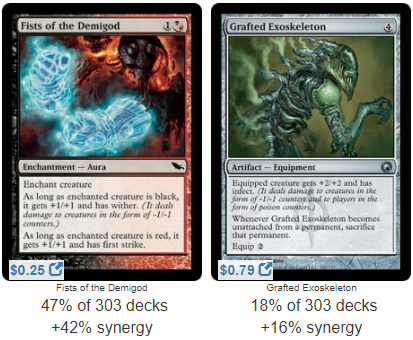
This is another good takeaway when comparing these -1/-1 commanders. Hapatra is a bit more linear. She's so good at what she does that it would be silly not to make a token deck with her. The Scorpion God has a few more options, from Control to Voltron to Reanimator to to Wither Tribal. It's a 'Jack of All Trades, Master of None' kind of situation.
Of course, there's one more strategy I have to mention for both commanders. Ready yourself, because this one's volcanically vengeful and visibly virulent.
Combo Nation
I'm not doing my job correctly if I don't mention the combos available to these commanders. As many already know, Blowfy InfestationBlowfy Infestation pairs exceptionally well with Nest of ScarabsNest of Scarabs. Putting a -1/-1 counter on a 1/1 creature triggers both enchantments, letting you place another counter on a creature and creating another 1/1 token. For complicated reasons, you need at least two 1-toughness creatures to get this combo started (state-based effects play a role, but the important part is that Blowfly InfestationBlowfly Infestation requires a target when its trigger is put on the stack, so you can't target the token Nest of Scarabs will createNest of Scarabs will create.) If you do meet the requirements, you can make an infinite loop of dying creatures, which synergizes all too well with both commanders.
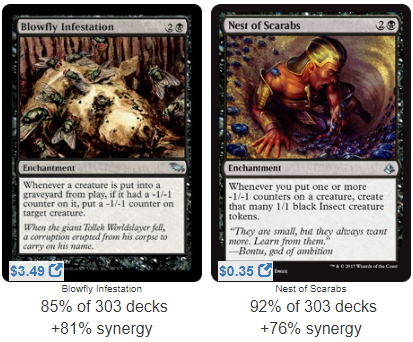
If you have Hapatra, Vizier of PoisonsHapatra, Vizier of Poisons on the battlefield, you'll be able to make an infinite snake army. That doesn't sound half bad, but Golgari can do you one better: what if you have Obelisk SpiderObelisk Spider on the battlefield? Or that pesky Blood ArtistBlood Artist? That's a lot of death. As long as you're in green, you can also replace Nest of ScarabsNest of Scarabs with Flourishing DefensesFlourishing Defenses.
When this combo is paired with The Scorpion GodThe Scorpion God, even more zaniness ensues: you draw your entire library. If you have a Purphoros, God of the ForgePurphoros, God of the Forge, you can cause a whole lot of mayhem that way as well.
Crucially, take note of the fact that many of these triggers aren't 'may' abilities. Blowfly InfestationBlowfly Infestation says you must put a -1/-1 counter on a creature, The Scorpion GodThe Scorpion God says you must draw a card. Once you get the loop going, you'll have to end it by eventually placing a counter on a creature with toughness greater than 1.
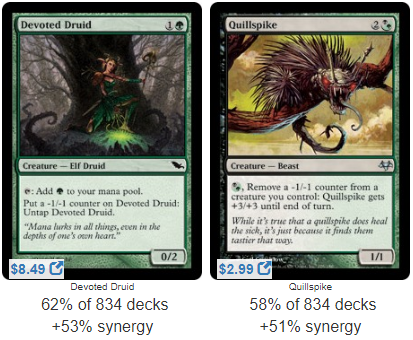
Hapatra has another famous combo up her sleeve as well: Devoted DruidDevoted Druid + QuillspikeQuillspike. By tapping Devoted DruidDevoted Druid for mana, untapping it by giving it a -1/-1 counter, then using that mana to eat the counter, you can make QuillspikeQuillspike an infinite/infinite creature in no time.
The Scorpion GodThe Scorpion God isn't done either. We mentioned reanimation effects earlier, and it didn't take competitive players very long to realize that the infamous Animate DeadAnimate Dead + Worldgorger DragonWorldgorger Dragon combo fit perfectly into Scorpy's colors. This combo can instantly give you an infinite amount of mana to play with. For players who'd like The Scorpion GodThe Scorpion God to have a little more sting, digging for these nasty combos is certainly a competitive option.
Cards to Consider
As always, I'd like to go through a few cards that I think each commander could stand to play little more often.
Hapatra
- Deathreap RitualDeathreap Ritual: This lucked into the average Hapatra deck, but it only has 34% popularity according to EDHREC, second to Phyrexian ArenaPhyrexian Arena's 41%. I know the Arena is a sexier card with lots of famous history, but Deathreap RitualDeathreap Ritual has a greater likelihood of drawing you more cards in a multiplayer game, and it's 1/4th the price.
- Viridian LongbowViridian Longbow: Okay, this one's silly, but those snakes have deathtouch. Give one of them the ability to ping other creatures and you've just made yourself a DIY Avatar of WoeAvatar of Woe. Thornbite StaffThornbite Staff and Pathway ArrowsPathway Arrows are other similar options.
- Thunderfoot BalothThunderfoot Baloth: Remember how deathtouch and trample mix really, really well? This is an OverrunOverrun that sticks around.
- Golgari CharmGolgari Charm: Board wipes suck, and this can save you from several of them. The other modes are useful as well. True, -1/-1 to all your creatures will kill off your tokens, but it still has uses where it'll finally kill off your opponents' weakened creatures. Besides, the option to destroy a Ghostly PrisonGhostly Prison or save your board from a Blasphemous ActBlasphemous Act is good enough to justify giving this card a second look.
- Sudden SpoilingSudden Spoiling: I'm taking a leaf out of The Scorpion GodThe Scorpion God's book here. Quite apart from the fact that this is just an excellent fog variant, turning creatures laden with -1/-1 counters into 0/2 weaklings is sure to wipe out quite a lot of dudes, leaving the coast clear for your slithery companions.
Scorpy
- Forbidden OrchardForbidden Orchard: This is another silly one, but it's entirely possible that the board will be empty and you'll have nothing to put a counter on. Why not make a creature yourself? You can always cash it in for cards later. In fact, if you're willing to take Scorpy down a political path, there are plenty of ways to hand out 1-toughness creatures. Varchild's War-RidersVarchild's War-Riders, Rite of the Raging StormRite of the Raging Storm, and Tempt with VengeanceTempt with Vengeance are perfect fodder for a well-timed Soul SnuffersSoul Snuffers or Black Sun's ZenithBlack Sun's Zenith.
- Disrupt DecorumDisrupt Decorum: This is the best red card from Commander 2017, and it's right at home in a deck like this. You don't need to play politics for it to be effective. If you like control, Disrupt DecorumDisrupt Decorum gives you exactly that, and creatures going into combat is a great way to make sure they die and draw you lots of cards.
- Revel in RichesRevel in Riches: Speaking of creatures dying, this card is insane. Play it immediately.
- Mikaeus, the UnhallowedMikaeus, the Unhallowed: Mike might as well be called Mikaeus the Unreasonably Expensive, but it has neat synergy with Scorpy. Combining Mikaeus's +1/+1 counters with Scorpy's -1/-1 counters negates both, which means they'll constantly have Undying, and become just as tough to keep dead as your commander. This is only really worth it if you have a lot of creatures, and most Scorpion lists aren't running too many, but if you do end up with a high creature density, this is a cool interaction.
- HeartstoneHeartstone: This is an easy one, but it's too good to ignore. Three mana for a single counter isn't very efficient, but two mana looks a lot better. Red and black need to cut corners and find mana wherever they can, so this is at least worth consideration.
Vipers and Vermin
Hapatra, Vizier of PoisonsHapatra, Vizier of Poisons and The Scorpion GodThe Scorpion God both use -1/-1 counters, but to vastly different ends. Hapatra is a token-making machine, while the Scorpion is a gradual commander that requires much more patience than you'd expect a red-black commander to demand. If you're interested in the actual act of applying counters to creatures, I suspect Hapatra has more to offer you. Indeed, since Hapatra has nearly three times as many decks as Scorpy, this seems to be the conclusion many other players have come to as well. The Scorpion GodThe Scorpion God's use of counters is more careful and reserved, generally tagging creatures once instead of piling counters on in droves.
With that said, the takeaway isn't necessarily that Hapatra is flat-out better than Scorpy at -1/-1 counters. Scorpy and other new cards like Mathas, Fiend SeekerMathas, Fiend Seeker represent an interesting turn for red-black-inclusive color combinations in EDH. We're used to these colors providing us with aggressive, combat-centric abilities, but as more of the world starts to pay attention to the Commander format, new designs start to stretch those boundaries. Hapatra's deck builds itself pretty easily, but I think Scorpy has the most potential for growth, as it represents a new and hitherto uncharted territory for its color pair. I'm excited to see what the future holds for alternative Rakdos strategies.
So, do you vote for the vain, valorous, and visionary Hapatra, or do you venerate the vengeful, volatile, vermilion Scorpion? Which vandal has the vitality and veracity to vanquish their opposing villain? The verdict is yours.
For now, I think I need a vacation.
Til next time!
Joseph Schultz
Joey is the lead editor and content producer for EDHREC. You can find him hosting and creating tons of great videos over at https://www.youtube.com/edhrecast or give him a follow at @JosephMSchultz on Twitter, where he likes to celebrate Commander, coffee, and corgis.
Your opinions are welcome. We love hearing what you think about Magic! We ask that you are always respectful when commenting. Please keep in mind how your comments could be interpreted by others. Personal attacks on our writers or other commenters will not be tolerated. Your comments may be removed if your language could be interpreted as aggressive or disrespectful. You may also be banned from writing further comments.
